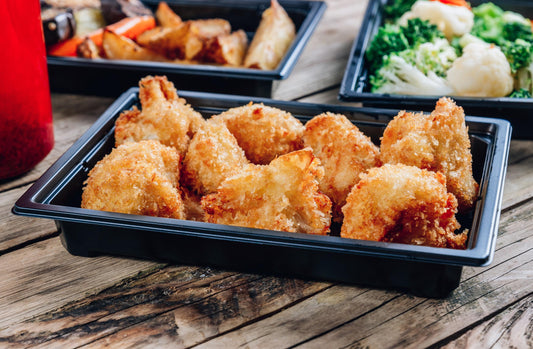The Coronavirus Pandemic has changed the dining landscape forever. Due to the long periods of restaurants being closed, or at best, with pickup and delivery options, diners of all stripes have grown used to the aforementioned pickup and delivery options. In the case of delivery, many now prefer the convenience of having meals delivered to their door. No cooking, no getting dressed up for a restaurant, no looking/paying for parking, etc. etc. As a result, the food delivery business has become a multi-billion dollar worldwide business in just a few short years.
From the perspective of the restaurant owner, Food Takeout Containers have attained a greatly elevated status in importance. And let’s not kid ourselves. It’s not just a case of stuffing the food into any old container and then sending it out for delivery. It won’t take a lot of messy leaks, soggy meals or cold meals that should be hot before you start losing customers. You need to understand what containers are best suited for your menu, as well as your budget and yes, your lifestyle choices too.
Here’s a general guide outlining several types of containers made from different kinds of materials. Your 3 main criteria are:
- Efficiency
- Cost.
- Lifestyle Choice (non-toxic, sustainable containers)
If COST is your only concern, then there are numerous cheap containers available. But if EFFICIENCY and THE ENVIRONMENT matter to you, then a few more pennies per container are necessary.
1. FOAM TAKEOUT CONTAINERS
Terrible for our environment, but they are ideal for hot liquids like soup and coffee because they they are microwaveable, they don’t leak and they provide great insulation from its hot contents, so the customer doesn’t burn themselves handling the containers. And they are cheap. But they don’t breathe, which means certain hot foods will get soggy from the contained steam that can’t escape. So do your research. Seen below is a Genpak - Hinged Foam Container - Dinner - Jumbo - 3 Comp.

2. PAPER TAKEOUT CONTAINERS (Cardboard & Paperboard)
Paper containers can also be microwaved with no negative effects on the food or the container. They can be used for a much wider range of foods than foam. Paper is eco-friendly, being biodegradable, however, like foam, they can result in soggy food due to its moisture retention qualities. They can also be hot to the touch. This can be avoided by a practice commonly used by Chinese takeout - put the paper containers in a paper bag. Seen here is a Eco-Craze - #3 Black Container

3. PLASTIC TAKEOUT CONTAINERS
This category is the most complex to analyze because of its constantly evolving technology. There’s an endless choice of cost effective and highly efficient products that are suitable for all kinds of hot, cold, wet and dry products. Plastic also ranges from safe to unsafe (toxic), microwaveable to non-microwaveable and eco-friendly to non-sustainable. Seen here is Canada #1 - 7" Black Plastic - Round Container Combo-H402CA

BEST FOR HOT FOODS
Be it paper or plastic, the best takeout containers for keeping food hot and crisp are those with ventilation. Some have vents strategically placed, others have hi-tec ventilation channels and some have both.
4. ALUMINUM TAKEOUT CONTAINERS
Aluminum containers are excellent for storing and reheating food in the oven or on the stove. They are also 100% recyclable - a plus for the environment. Seen here is a Rhino-Foil - RETAIL - 2 1/4 lb Oblong - Aluminium Foil Container

5. ECO-FRIENDLY TAKEOUT CONTAINERS
As today’s buying public (and restaurant owners) become more and more aware of the benefits to the planet of eco-friendly packaging and containers. The “cheapest is best” approach falls short of what many people today believe they should be doing to help the planet they live on. Your choice is slowly becoming mandated as more and more municipalities are restricting the use of certain plastics. Here in southern Ontario, plastic bags will no longer be available for bagging your groceries by the end of 2022. All these new regulations and new way of consumer thinking had meant a huge boost to the manufacturing of eco-friendly packaging and container. And as competition in the sector increases, prices come down. As such, the eco-friendly category has become an affordable and rapidly growing area of the takeout container industry. Seen here is a Eco-Craze - 9X9 Bagasse Clamshell Container

Using a variety of materials such as compostable sugarcane fibre, biodegradable and compostable molded fibre, natural plant material like corn-based Ingeo natural plastic, as well as certain minerals and plant-based starches; manufacturers have been able to drastically reduce and eliminate unsafe materials and increase the sustainability of takeout containers.
Caring about the environment has become an affordable and efficient alternative to the standard foam and the old toxic plastic.


